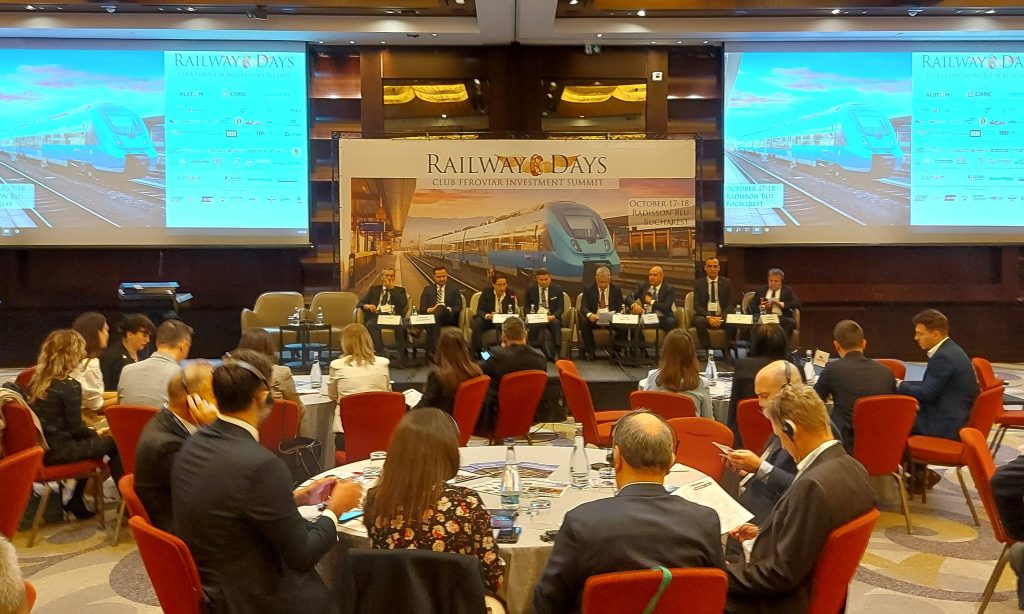 “Romania’s rail infrastructure projects which are nor undergoing have a value of EUR 6 billion, of which EUR 3.5 billion are provided through the National Recovery and Resilience Plan (PNRR) and the degree of contracting from PNRR currently exceeds 90%. EUR 2.5 billion is the value of the projects which are covered by the Cohesion Fund under the operational programmes and the Connecting Europe Facility. The rail projects are massively funded compared to the previous period and in the next years the results we will see the results,” said Ionuț Săvoiu, the State Secretary at the Romanian Ministry of Transport and Infrastructure, during the Railway Days Investment Summit held in Bucharest on 17 – 18 October 2023.
“Romania’s rail infrastructure projects which are nor undergoing have a value of EUR 6 billion, of which EUR 3.5 billion are provided through the National Recovery and Resilience Plan (PNRR) and the degree of contracting from PNRR currently exceeds 90%. EUR 2.5 billion is the value of the projects which are covered by the Cohesion Fund under the operational programmes and the Connecting Europe Facility. The rail projects are massively funded compared to the previous period and in the next years the results we will see the results,” said Ionuț Săvoiu, the State Secretary at the Romanian Ministry of Transport and Infrastructure, during the Railway Days Investment Summit held in Bucharest on 17 – 18 October 2023.
Romania is focused to modernise the European Transport Corridors (ETC) on its territory and to develop its rail connections with its neighboring countries. As an example is the rail link with Hungary for which the country’s rail infrastructure manager CFR SA signed in 202 two contracts for the modernisation and electrification of the Cluj Napoca-Episcopia Bihor railway line which via Oradea provides the connection to the border with Hungary.
In this context, in May, Transport Ministers of Romania and Poland signed a joint declaration committing to develop the Rail2Sea corridor. This will create a rail connection between the Baltics through the Port of Gdansk and the Black Sea at the Port of Constanta, crossing Poland, Slovakia, Hungary and Romania.
Other important Romania’s rail infrastructure projects involve the links with Ukraine, which in this time of war is essential to ensure the supply chain and facilitate transit flows. This year, several vital steps were carried out which included the upgrade of the connections and the launch of passenger train between Viseul Valley (in Romania) and Rahov (in Ukraine), after 17 years of closure. For freight transport, the DP World arranged to facilitate transit services between Ukraine and Romania (through the Port of Constanta) using an intermodal terminal in Dornesti.
The Strategy for the EU integration of the Ukrainian and Moldovan rail Systems, a study published by the European Commission and the European Investment Bank highlights the need of upgrading and develop the cross border connections between Romania and Ukraine. A pre-feasibility study has been developed for a new EU standard-gauge rail corridor between Poland, Ukraine, Romania and Moldova on the Krakow – Lviv – Iasi – Chisinau route which will also integrate Ukraine and the Republic of Moldova into the EU rail system.
In this matter, Oleg Tofilat the Director General of Calea Ferată din Moldova (CFM) said, during the summit, that “the war brought an uncertain and turbulent situation, but also underlined the potential opportunities for better rail infrastructure and services as well as for the business environment. More than ever, we realised that we need a better logistics chain, especially to ensure traffic flows from Ukraine. The fact that we are candidate members of the EU [the EU granted Moldova the candidate status in June 2022] brings new benefits and opportunities to integrate our railway system with the EU through the extension of TEN-T. In this context, the collaboration with Romania is one of the essential steps to be implemented. In the last two years, our cooperation with Romania resulted in doubling the number of rail operators with direct contracts. At the same time, we have managed to massively increase, over expectations, the volume of cargo transported on Moldova’s railways.”
The Republic of Moldova is supported by the EU and the European banks to modernise and develop its railway network. This year, the country obtained a EBRD financing for its North – South rail corridor which will ensure better freight flows between Ukraine, Romania and towards the European Union.
In September, the Government of Moldova announced its intentions to elaborate a rail strategy to develop rail infrastructure at its western border. Also in September, Moldova’s Minister of Infrastructure underlined the necessity of including his country into the Three Seas initiative covering both rail and road transport projects.
Share on:



